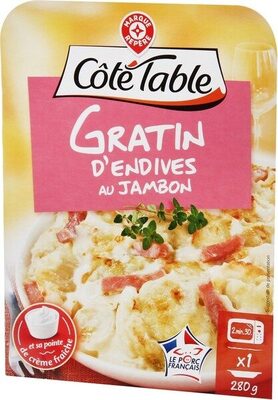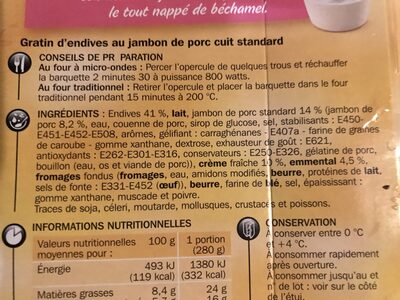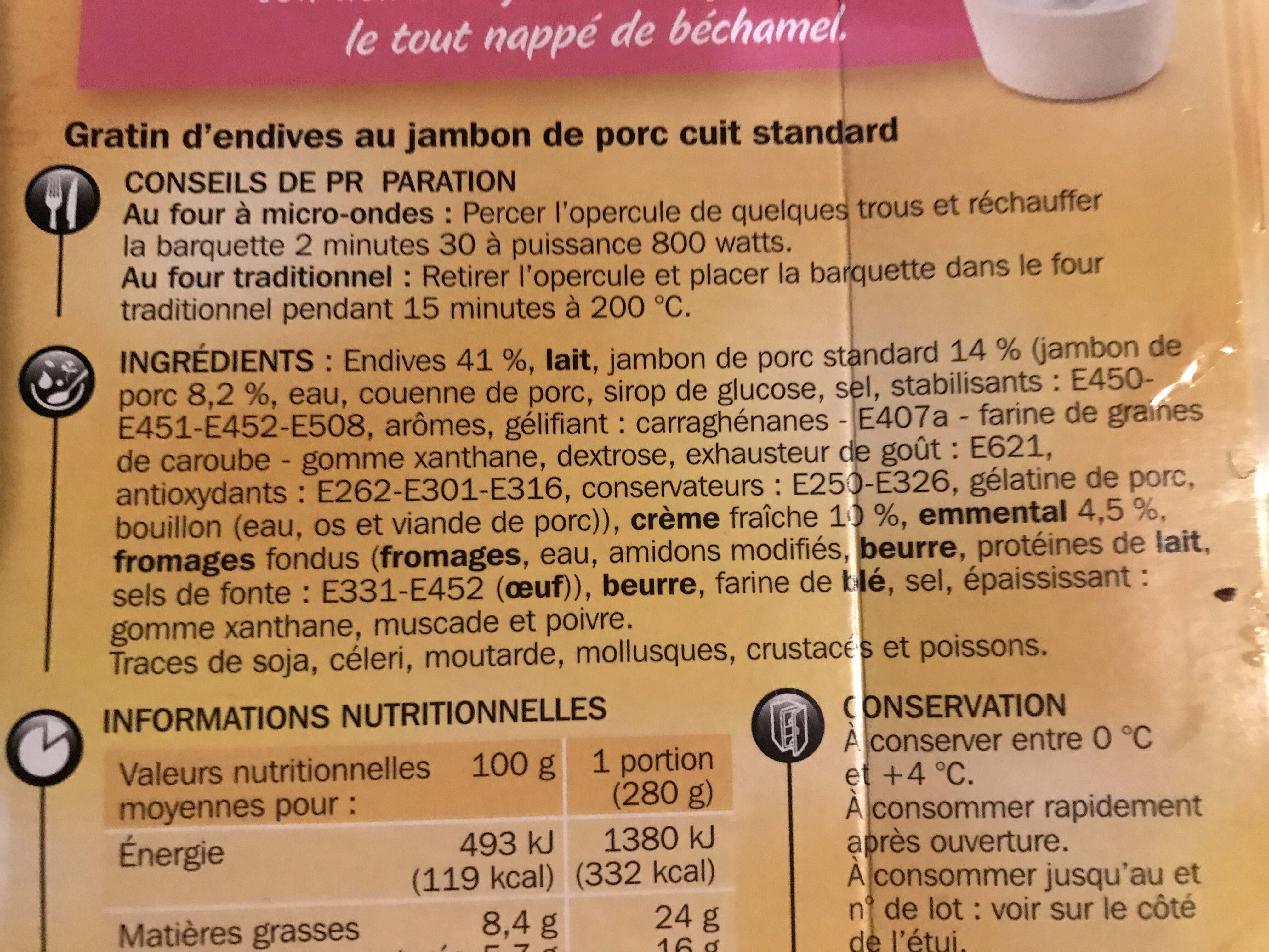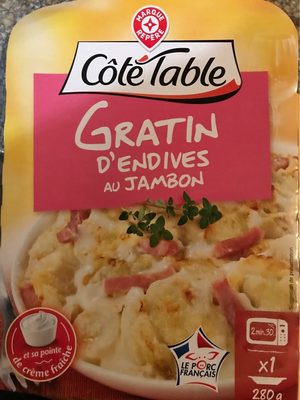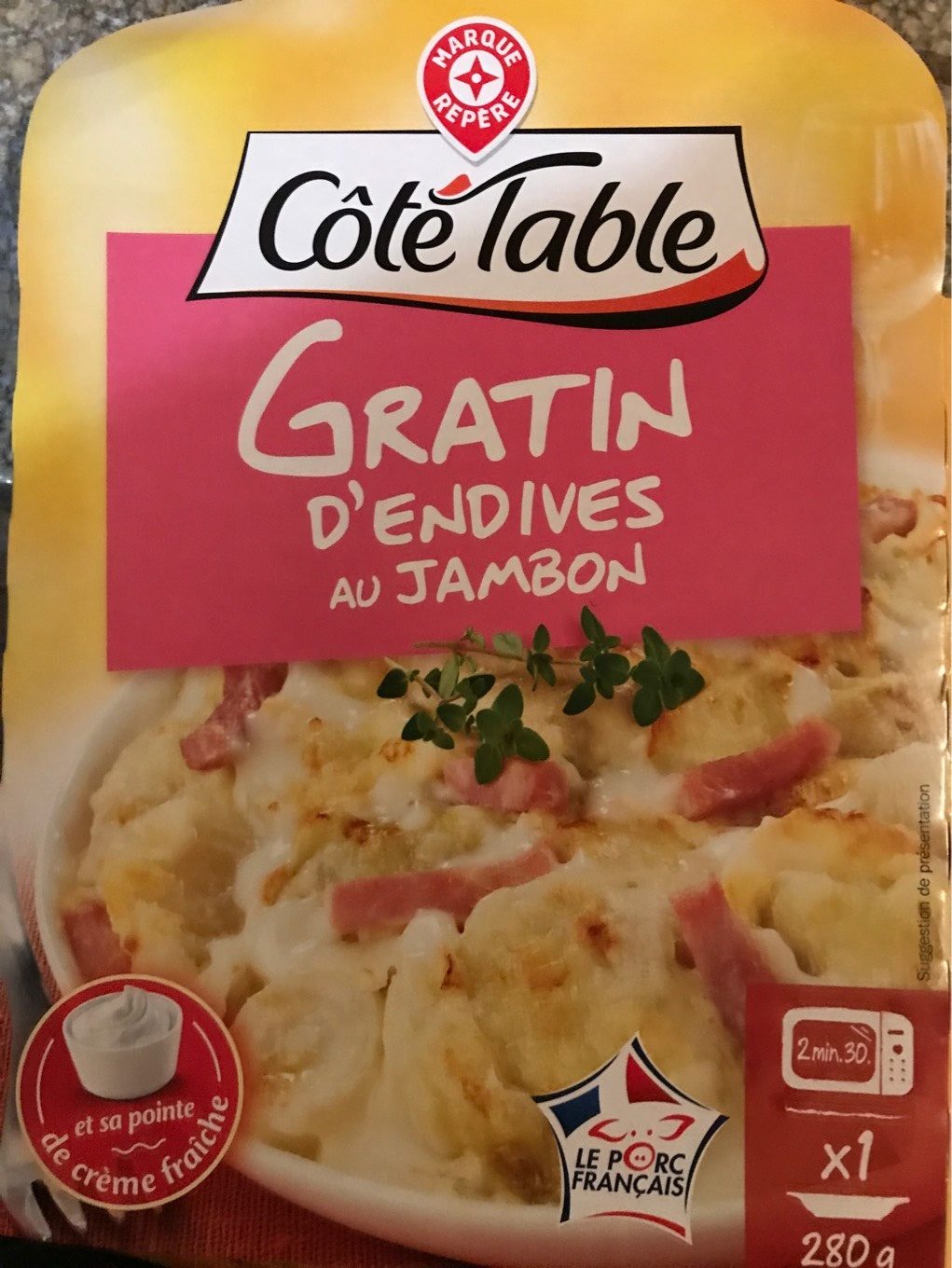Help us make food transparency the norm!
As a non-profit organization, we depend on your donations to continue informing consumers around the world about what they eat.
The food revolution starts with you!
Gratin d'endives au jambon - Côté Table - 280 g
Gratin d'endives au jambon - Côté Table - 280 g
This product page is not complete. You can help to complete it by editing it and adding more data from the photos we have, or by taking more photos using the app for Android or iPhone/iPad. Thank you!
×
Some of the data for this product has been provided directly by the manufacturer Scamark.
Barcode: 3564700768730 (EAN / EAN-13)
Quantity: 280 g
Brands: Côté Table, Marque Repère
Categories: Meals, Gratins, Endives with ham, fr:Gratins d'endives au jambon
Labels, certifications, awards: French meat, French pork
Stores: Leclerc
Countries where sold: France
Matching with your preferences
Health
Ingredients
-
100 ingredients
: endive émincée 37%, lait demi-écrémé, jambon cuit choix 14% [jambon de porc (origine : ue) ; eau ; dextrose ; sel ; arômes naturels ; stabilisants : e450, e451 ; antioxydant : ascorbate de sodium ; conservateur : e250)], crème fraîche 9.7%, préparation laitière en poudre (lactose, protéines de lait, crème), farine de blé, emmental 2.1%, sel, épaississant : gomme xanthane, muscade, poivre, paprika, colorant : caramel ordinaire, curcuma. endives 41%, {allergene}lait{/allergene}, jambon de porc standard 14% (jambon de porc 8,2%, eau, couenne de porc, sirop de glucose, sel, stabilisants: e450 - e451-e452-e508, aromes, gelifiant: carraghenanes-e407a-farine de graines de caroube-gomme xanthane, dextrose, exhausteur de gout: e621, antioxydants: e262-e301-e316, conservateurs:e250-e326,gelatine de porc, bouillon (eau, os et viande de porc)), creme fraiche 10%, {allergene}emmental{/allergene} 4,5%, {allergene}fromages{/allergene} fondus ({allergene}fromages{/allergene}, eau, amidons modifies, {allergene}beurre{/allergene}, proteines de {allergene}lait{/allergene}, sels de fonte: e331-e452 ( {allergene}oeuf{/allergene})), {allergene}beurre{/allergene}, farine de {allergene}ble{/allergene}, sel, epaississant: gomme xanthane, muscade et poivre. {traces}traces de soja, celeri, moutarde, mollusques, crustaces et poissons.{/traces}Allergens: Eggs, Gluten, MilkTraces: Celery, Crustaceans, Eggs, Fish, Molluscs, Mustard, Soybeans
Food processing
-
Ultra processed foods
Elements that indicate the product is in the 4 - Ultra processed food and drink products group:
- Additive: E14XX - Modified Starch
- Additive: E150a - Plain caramel
- Additive: E326 - Potassium lactate
- Additive: E407 - Carrageenan
- Additive: E407a - Processed eucheuma seaweed
- Additive: E415 - Xanthan gum
- Additive: E428 - Gelatine
- Additive: E450 - Diphosphates
- Additive: E451 - Triphosphates
- Additive: E452 - Polyphosphates
- Additive: E621 - Monosodium glutamate
- Ingredient: Colour
- Ingredient: Dextrose
- Ingredient: Flavour enhancer
- Ingredient: Flavouring
- Ingredient: Gelling agent
- Ingredient: Glucose
- Ingredient: Glucose syrup
- Ingredient: Lactose
- Ingredient: Milk proteins
- Ingredient: Thickener
Food products are classified into 4 groups according to their degree of processing:
- Unprocessed or minimally processed foods
- Processed culinary ingredients
- Processed foods
- Ultra processed foods
The determination of the group is based on the category of the product and on the ingredients it contains.
Additives
-
E250 - Sodium nitrite
Sodium nitrite: Sodium nitrite is the inorganic compound with the chemical formula NaNO2. It is a white to slightly yellowish crystalline powder that is very soluble in water and is hygroscopic. It is a useful precursor to a variety of organic compounds, such as pharmaceuticals, dyes, and pesticides, but it is probably best known as a food additive to prevent botulism. It is on the World Health Organization's List of Essential Medicines, the most important medications needed in a basic health system.Nitrate or nitrite -ingested- under conditions that result in endogenous nitrosation has been classified as "probably carcinogenic to humans" by International Agency for Research on Cancer -IARC-.Source: Wikipedia
-
E262 - Sodium acetates
Sodium acetate: Sodium acetate, CH3COONa, also abbreviated NaOAc, is the sodium salt of acetic acid. This colorless deliquescent salt has a wide range of uses.Source: Wikipedia
-
E301 - Sodium ascorbate
Sodium ascorbate: Sodium ascorbate is one of a number of mineral salts of ascorbic acid -vitamin C-. The molecular formula of this chemical compound is C6H7NaO6. As the sodium salt of ascorbic acid, it is known as a mineral ascorbate. It has not been demonstrated to be more bioavailable than any other form of vitamin C supplement.Sodium ascorbate normally provides 131 mg of sodium per 1‚000 mg of ascorbic acid -1‚000 mg of sodium ascorbate contains 889 mg of ascorbic acid and 111 mg of sodium-. As a food additive, it has the E number E301 and is used as an antioxidant and an acidity regulator. It is approved for use as a food additive in the EU, USA, and Australia and New Zealand.In in vitro studies, sodium ascorbate has been found to produce cytotoxic effects in various malignant cell lines, which include melanoma cells that are particularly susceptible.Source: Wikipedia
-
E316 - Sodium erythorbate
Sodium erythorbate: Sodium erythorbate -C6H7NaO6- is a food additive used predominantly in meats, poultry, and soft drinks. Chemically, it is the sodium salt of erythorbic acid. When used in processed meat such as hot dogs and beef sticks, it increases the rate at which nitrite reduces to nitric oxide, thus facilitating a faster cure and retaining the pink coloring. As an antioxidant structurally related to vitamin C, it helps improve flavor stability and prevents the formation of carcinogenic nitrosamines. When used as a food additive, its E number is E316. The use of erythorbic acid and sodium erythorbate as a food preservative has increased greatly since the U.S. Food and Drug Administration banned the use of sulfites as preservatives in foods intended to be eaten fresh -such as ingredients for fresh salads- and as food processors have responded to the fact that some people are allergic to sulfites. It can also be found in bologna, and is occasionally used in beverages, baked goods, and potato salad.Sodium erythorbate is produced from sugars derived from different sources, such as beets, sugar cane, and corn. An urban myth claims that sodium erythorbate is made from ground earthworms; however, there is no truth to the myth. It is thought that the genesis of the legend comes from the similarity of the chemical name to the words earthworm and bait.Alternative applications include the development of additives that could be utilized as anti-oxidants in general. For instance, this substance has been implemented in the development of corrosion inhibitors for metals and it has been implemented in active packaging.Sodium erythorbate is soluble in water. The pH of the aqueous solution of the sodium salt is between 5 and 6. A 10% solution, made from commercial grade sodium erythorbate, may have a pH of 7.2 to 7.9. In its dry, crystalline state it is nonreactive. But, when in solution with water it readily reacts with atmospheric oxygen and other oxidizing agents, which makes it a valuable antioxidant.Source: Wikipedia
-
E326 - Potassium lactate
Potassium lactate: Potassium lactate is a compound with formula KC3H5O3, or H3C-CHOH-COOK. It is the potassium salt of lactic acid. It is produced by neutralizing lactic acid which is fermented from a sugar source. It has E number "E326". Potassium lactate is a liquid product that is usually 60% solids but is available at up to 78% solids.Potassium lactate is commonly used in meat and poultry products to extend shelf life and increase food safety as it has a broad antimicrobial action and is effective at inhibiting most spoilage and pathogenic bacteria. Potassium lactate is also used as an extinguishing medium in the First Alert Tundra fire extinguishers.Source: Wikipedia
-
E331 - Sodium citrates
Sodium citrate: Sodium citrate may refer to any of the sodium salts of citrate -though most commonly the third-: Monosodium citrate Disodium citrate Trisodium citrateThe three forms of the salt are collectively known by the E number E331. Sodium citrates are used as acidity regulators in food and drinks, and also as emulsifiers for oils. They enable cheeses to melt without becoming greasy.Source: Wikipedia
-
E407 - Carrageenan
Carrageenan (E407), derived from red seaweed, is widely employed in the food industry as a gelling, thickening, and stabilizing agent, notably in dairy and meat products.
It can exist in various forms, each imparting distinct textural properties to food.
However, its degraded form, often referred to as poligeenan, has raised health concerns due to its potential inflammatory effects and its classification as a possible human carcinogen (Group 2B) by the International Agency for Research on Cancer (IARC).
Nevertheless, food-grade carrageenan has been deemed safe by various regulatory bodies when consumed in amounts typically found in food.
-
E407a - Processed eucheuma seaweed
Carrageenan: Carrageenans or carrageenins - karr-ə-gee-nənz, from Irish carraigín, "little rock"- are a family of linear sulfated polysaccharides that are extracted from red edible seaweeds. They are widely used in the food industry, for their gelling, thickening, and stabilizing properties. Their main application is in dairy and meat products, due to their strong binding to food proteins. There are three main varieties of carrageenan, which differ in their degree of sulfation. Kappa-carrageenan has one sulfate group per disaccharide, iota-carrageenan has two, and lambda-carrageenan has three. Gelatinous extracts of the Chondrus crispus -Irish moss- seaweed have been used as food additives since approximately the fifteenth century. Carrageenan is a vegetarian and vegan alternative to gelatin in some applications or may be used to replace gelatin in confectionery.Source: Wikipedia
-
E415 - Xanthan gum
Xanthan gum (E415) is a natural polysaccharide derived from fermented sugars, often used in the food industry as a thickening and stabilizing agent.
This versatile food additive enhances texture and prevents ingredient separation in a wide range of products, including salad dressings, sauces, and gluten-free baked goods.
It is considered safe for consumption even at high intake amounts.
-
E450 - Diphosphates
Diphosphates (E450) are food additives often utilized to modify the texture of products, acting as leavening agents in baking and preventing the coagulation of canned food.
These salts can stabilize whipped cream and are also found in powdered products to maintain their flow properties. They are commonly present in baked goods, processed meats, and soft drinks.
Derived from phosphoric acid, they're part of our daily phosphate intake, which often surpasses recommended levels due to the prevalence of phosphates in processed foods and drinks.
Excessive phosphate consumption is linked to health issues, such as impaired kidney function and weakened bone health. Though diphosphates are generally regarded as safe when consumed within established acceptable daily intakes, it's imperative to monitor overall phosphate consumption to maintain optimal health.
-
E451 - Triphosphates
Sodium triphosphate: Sodium triphosphate -STP-, also sodium tripolyphosphate -STPP-, or tripolyphosphate -TPP-,- is an inorganic compound with formula Na5P3O10. It is the sodium salt of the polyphosphate penta-anion, which is the conjugate base of triphosphoric acid. It is produced on a large scale as a component of many domestic and industrial products, especially detergents. Environmental problems associated with eutrophication are attributed to its widespread use.Source: Wikipedia
-
E508 - Potassium chloride
Potassium chloride: Potassium chloride -KCl- is a metal halide salt composed of potassium and chlorine. It is odorless and has a white or colorless vitreous crystal appearance. The solid dissolves readily in water and its solutions have a salt-like taste. KCl is used as a fertilizer, in medicine, in scientific applications, and in food processing. In a few states of the United States it is used to cause cardiac arrest as the third drug in the "three drug cocktail" for executions by lethal injection. It occurs naturally as the mineral sylvite, and in combination with sodium chloride as sylvinite.The version for injection is on the World Health Organization's List of Essential Medicines, the most important medications needed in a basic health system.Source: Wikipedia
-
E621 - Monosodium glutamate
Monosodium glutamate: Monosodium glutamate -MSG, also known as sodium glutamate- is the sodium salt of glutamic acid, one of the most abundant naturally occurring non-essential amino acids. Glutamic acid is found naturally in tomatoes, grapes, cheese, mushrooms and other foods.MSG is used in the food industry as a flavor enhancer with an umami taste that intensifies the meaty, savory flavor of food, as naturally occurring glutamate does in foods such as stews and meat soups. It was first prepared in 1908 by Japanese biochemist Kikunae Ikeda, who was trying to isolate and duplicate the savory taste of kombu, an edible seaweed used as a base for many Japanese soups. MSG as a flavor enhancer balances, blends, and rounds the perception of other tastes.The U.S. Food and Drug Administration has given MSG its generally recognized as safe -GRAS- designation. A popular belief is that large doses of MSG can cause headaches and other feelings of discomfort, known as "Chinese restaurant syndrome," but double-blind tests fail to find evidence of such a reaction. The European Union classifies it as a food additive permitted in certain foods and subject to quantitative limits. MSG has the HS code 29224220 and the E number E621.Source: Wikipedia
Ingredients analysis
-
Palm oil content unknown
Unrecognized ingredients: fr:preparation-laitiere-en-poudre, fr:allergene, fr:allergene, fr:jambon-de-porc-standard, fr:e407a-farine-de-graines-de-caroube-gomme-xanthane, fr:allergene, fr:allergene, fr:allergene, fr:allergene, fr:fondus, fr:allergene, fr:allergene, fr:allergene, fr:allergene, fr:allergene, fr:allergene, fr:allergene, fr:allergene, fr:allergene, fr:allergeneSome ingredients could not be recognized.
We need your help!
You can help us recognize more ingredients and better analyze the list of ingredients for this product and others:
- Edit this product page to correct spelling mistakes in the ingredients list, and/or to remove ingredients in other languages and sentences that are not related to the ingredients.
- Add new entries, synonyms or translations to our multilingual lists of ingredients, ingredient processing methods, and labels.
If you would like to help, join the #ingredients channel on our Slack discussion space and/or learn about ingredients analysis on our wiki. Thank you!
-
Non-vegan
Non-vegan ingredients: Semi-skimmed milk, fr:Jambon cuit choix, Ham, Fresh cream, Lactose, Milk proteins, Cream, Emmental, Milk, Ham, fr:Couenne de porc, Pork gelatin, Fresh cream, Emmental, Cheese, Cheese, Butter, Milk, Egg, ButterSome ingredients could not be recognized.
We need your help!
You can help us recognize more ingredients and better analyze the list of ingredients for this product and others:
- Edit this product page to correct spelling mistakes in the ingredients list, and/or to remove ingredients in other languages and sentences that are not related to the ingredients.
- Add new entries, synonyms or translations to our multilingual lists of ingredients, ingredient processing methods, and labels.
If you would like to help, join the #ingredients channel on our Slack discussion space and/or learn about ingredients analysis on our wiki. Thank you!
-
Non-vegetarian
Non-vegetarian ingredients: fr:Jambon cuit choix, Ham, Ham, fr:Couenne de porc, Pork gelatinSome ingredients could not be recognized.
We need your help!
You can help us recognize more ingredients and better analyze the list of ingredients for this product and others:
- Edit this product page to correct spelling mistakes in the ingredients list, and/or to remove ingredients in other languages and sentences that are not related to the ingredients.
- Add new entries, synonyms or translations to our multilingual lists of ingredients, ingredient processing methods, and labels.
If you would like to help, join the #ingredients channel on our Slack discussion space and/or learn about ingredients analysis on our wiki. Thank you!
-
Details of the analysis of the ingredients
We need your help!
Some ingredients could not be recognized.
We need your help!
You can help us recognize more ingredients and better analyze the list of ingredients for this product and others:
- Edit this product page to correct spelling mistakes in the ingredients list, and/or to remove ingredients in other languages and sentences that are not related to the ingredients.
- Add new entries, synonyms or translations to our multilingual lists of ingredients, ingredient processing methods, and labels.
If you would like to help, join the #ingredients channel on our Slack discussion space and/or learn about ingredients analysis on our wiki. Thank you!
: endive 37%, lait demi-écrémé, jambon cuit choix 14% (jambon de porc, eau, dextrose, sel, arômes naturels, stabilisants (e450), e451, antioxydant (ascorbate de sodium), conservateur (e250)), crème fraîche 9.7%, préparation laitière en poudre (lactose, protéines de lait, crème), farine de blé, emmental 2.1%, sel, épaississant (gomme xanthane), muscade, poivre, paprika, colorant (caramel ordinaire), curcuma, endives 41% (allergene), lait (allergene), jambon de porc standard 14% (jambon de porc 8.2%, eau, couenne de porc, sirop de glucose, sel, stabilisants (e450), e451, e452, e508, aromes, gelifiant (carraghenanes), e407a-farine de graines de caroube-gomme xanthane, dextrose, exhausteur de gout (e621), antioxydants (e262), e301, e316, conservateurs (e250), e326, gelatine de porc, bouillon (eau, os et viande de porc)), creme fraiche 10% (allergene), emmental 4.5% (allergene, allergene), fromages (allergene), fondus (fromages (allergene), eau, amidons modifies (allergene), beurre (allergene), proteines de (allergene), lait (allergene), sels de fonte (e331), e452 (oeuf (allergene)), allergene), beurre (allergene), farine de (allergene), ble (allergene), sel, epaississant (gomme xanthane), muscade, poivre- endive -> en:belgian-endive - vegan: yes - vegetarian: yes - ciqual_food_code: 20026 - percent: 37
- lait demi-écrémé -> en:semi-skimmed-milk - vegan: no - vegetarian: yes - ciqual_proxy_food_code: 19041
- jambon cuit choix -> fr:jambon-cuit-choix - vegan: no - vegetarian: no - ciqual_proxy_food_code: 28205 - percent: 14
- jambon de porc -> en:ham - vegan: no - vegetarian: no - ciqual_proxy_food_code: 28205
- eau -> en:water - vegan: yes - vegetarian: yes - ciqual_food_code: 18066
- dextrose -> en:dextrose - vegan: yes - vegetarian: yes - ciqual_proxy_food_code: 31016
- sel -> en:salt - vegan: yes - vegetarian: yes - ciqual_food_code: 11058
- arômes naturels -> en:natural-flavouring - vegan: maybe - vegetarian: maybe
- stabilisants -> en:stabiliser
- e450 -> en:e450 - vegan: yes - vegetarian: yes
- e451 -> en:e451 - vegan: yes - vegetarian: yes
- antioxydant -> en:antioxidant
- ascorbate de sodium -> en:e301 - vegan: yes - vegetarian: yes
- conservateur -> en:preservative
- e250 -> en:e250 - vegan: yes - vegetarian: yes
- crème fraîche -> en:fresh-cream - vegan: no - vegetarian: yes - ciqual_food_code: 19402 - percent: 9.7
- préparation laitière en poudre -> fr:preparation-laitiere-en-poudre
- lactose -> en:lactose - vegan: no - vegetarian: yes
- protéines de lait -> en:milk-proteins - vegan: no - vegetarian: yes
- crème -> en:cream - vegan: no - vegetarian: yes - ciqual_food_code: 19402
- farine de blé -> en:wheat-flour - vegan: yes - vegetarian: yes - ciqual_proxy_food_code: 9410
- emmental -> en:emmental - vegan: no - vegetarian: maybe - ciqual_food_code: 12115 - percent: 2.1
- sel -> en:salt - vegan: yes - vegetarian: yes - ciqual_food_code: 11058
- épaississant -> en:thickener
- gomme xanthane -> en:e415 - vegan: yes - vegetarian: yes
- muscade -> en:nutmeg - vegan: yes - vegetarian: yes - ciqual_food_code: 11048
- poivre -> en:pepper - vegan: yes - vegetarian: yes
- paprika -> en:paprika - vegan: yes - vegetarian: yes - ciqual_food_code: 11049
- colorant -> en:colour
- caramel ordinaire -> en:e150a - vegan: yes - vegetarian: yes
- curcuma -> en:turmeric - vegan: yes - vegetarian: yes - ciqual_proxy_food_code: 11089
- endives -> en:belgian-endive - vegan: yes - vegetarian: yes - ciqual_food_code: 20026 - percent: 41
- allergene -> fr:allergene
- lait -> en:milk - vegan: no - vegetarian: yes - ciqual_proxy_food_code: 19051
- allergene -> fr:allergene
- jambon de porc standard -> fr:jambon-de-porc-standard - percent: 14
- jambon de porc -> en:ham - vegan: no - vegetarian: no - ciqual_proxy_food_code: 28205 - percent: 8.2
- eau -> en:water - vegan: yes - vegetarian: yes - ciqual_food_code: 18066
- couenne de porc -> fr:couenne-de-porc - vegan: no - vegetarian: no - ciqual_proxy_food_code: 28205
- sirop de glucose -> en:glucose-syrup - vegan: yes - vegetarian: yes - ciqual_proxy_food_code: 31016
- sel -> en:salt - vegan: yes - vegetarian: yes - ciqual_food_code: 11058
- stabilisants -> en:stabiliser
- e450 -> en:e450 - vegan: yes - vegetarian: yes
- e451 -> en:e451 - vegan: yes - vegetarian: yes
- e452 -> en:e452 - vegan: yes - vegetarian: yes
- e508 -> en:e508 - vegan: yes - vegetarian: yes
- aromes -> en:flavouring - vegan: maybe - vegetarian: maybe
- gelifiant -> en:gelling-agent
- carraghenanes -> en:e407 - vegan: yes - vegetarian: yes
- e407a-farine de graines de caroube-gomme xanthane -> fr:e407a-farine-de-graines-de-caroube-gomme-xanthane
- dextrose -> en:dextrose - vegan: yes - vegetarian: yes - ciqual_proxy_food_code: 31016
- exhausteur de gout -> en:flavour-enhancer
- e621 -> en:e621 - vegan: yes - vegetarian: yes
- antioxydants -> en:antioxidant
- e262 -> en:e262 - vegan: yes - vegetarian: yes
- e301 -> en:e301 - vegan: yes - vegetarian: yes
- e316 -> en:e316 - vegan: yes - vegetarian: yes
- conservateurs -> en:preservative
- e250 -> en:e250 - vegan: yes - vegetarian: yes
- e326 -> en:e326 - vegan: yes - vegetarian: yes
- gelatine de porc -> en:pork-gelatin - vegan: no - vegetarian: no
- bouillon -> en:broth
- eau -> en:water - vegan: yes - vegetarian: yes - ciqual_food_code: 18066
- os et viande de porc -> fr:os-et-viande-de-porc
- creme fraiche -> en:fresh-cream - vegan: no - vegetarian: yes - ciqual_food_code: 19402 - percent: 10
- allergene -> fr:allergene
- emmental -> en:emmental - vegan: no - vegetarian: maybe - ciqual_food_code: 12115 - percent: 4.5
- allergene -> fr:allergene
- allergene -> fr:allergene
- fromages -> en:cheese - vegan: no - vegetarian: maybe - ciqual_proxy_food_code: 12999
- allergene -> fr:allergene
- fondus -> fr:fondus
- fromages -> en:cheese - vegan: no - vegetarian: maybe - ciqual_proxy_food_code: 12999
- allergene -> fr:allergene
- eau -> en:water - vegan: yes - vegetarian: yes - ciqual_food_code: 18066
- amidons modifies -> en:modified-starch - vegan: yes - vegetarian: yes - ciqual_proxy_food_code: 9510
- allergene -> fr:allergene
- beurre -> en:butter - vegan: no - vegetarian: yes - ciqual_proxy_food_code: 16400
- allergene -> fr:allergene
- proteines de -> en:protein - vegan: maybe - vegetarian: maybe
- allergene -> fr:allergene
- lait -> en:milk - vegan: no - vegetarian: yes - ciqual_proxy_food_code: 19051
- allergene -> fr:allergene
- sels de fonte -> en:emulsifying-salts
- e331 -> en:e331 - vegan: yes - vegetarian: yes
- e452 -> en:e452 - vegan: yes - vegetarian: yes
- oeuf -> en:egg - vegan: no - vegetarian: yes - ciqual_food_code: 22000
- allergene -> fr:allergene
- oeuf -> en:egg - vegan: no - vegetarian: yes - ciqual_food_code: 22000
- allergene -> fr:allergene
- fromages -> en:cheese - vegan: no - vegetarian: maybe - ciqual_proxy_food_code: 12999
- beurre -> en:butter - vegan: no - vegetarian: yes - ciqual_proxy_food_code: 16400
- allergene -> fr:allergene
- farine de -> en:flour - vegan: yes - vegetarian: yes - ciqual_proxy_food_code: 9410
- allergene -> fr:allergene
- ble -> en:wheat - vegan: yes - vegetarian: yes - ciqual_proxy_food_code: 9410
- allergene -> fr:allergene
- sel -> en:salt - vegan: yes - vegetarian: yes - ciqual_food_code: 11058
- epaississant -> en:thickener
- gomme xanthane -> en:e415 - vegan: yes - vegetarian: yes
- muscade -> en:nutmeg - vegan: yes - vegetarian: yes - ciqual_food_code: 11048
- poivre -> en:pepper - vegan: yes - vegetarian: yes
en:meat -> en:meat
en:pork -> en:pork
Nutrition
-
Average nutritional quality
This product is not considered a beverage for the calculation of the Nutri-Score.
Positive points: 4
- Proteins: 3 / 5 (value: 5.2, rounded value: 5.2)
- Fiber: 1 / 5 (value: 1.7, rounded value: 1.7)
- Fruits, vegetables, nuts, and colza/walnut/olive oils: 0 / 5 (value: 37.2, rounded value: 37.2)
Negative points: 7
- Energy: 1 / 10 (value: 493, rounded value: 493)
- Sugars: 0 / 10 (value: 3.3, rounded value: 3.3)
- Saturated fat: 3 / 10 (value: 3.7, rounded value: 3.7)
- Sodium: 3 / 10 (value: 320, rounded value: 320)
The points for proteins are counted because the negative points are less than 11.
Nutritional score: (7 - 4)
Nutri-Score:
-
Nutrient levels
-
Fat in moderate quantity (5.9%)
What you need to know- A high consumption of fat, especially saturated fats, can raise cholesterol, which increases the risk of heart diseases.
Recommendation: Limit the consumption of fat and saturated fat- Choose products with lower fat and saturated fat content.
-
Saturated fat in moderate quantity (3.7%)
What you need to know- A high consumption of fat, especially saturated fats, can raise cholesterol, which increases the risk of heart diseases.
Recommendation: Limit the consumption of fat and saturated fat- Choose products with lower fat and saturated fat content.
-
Sugars in low quantity (3.3%)
What you need to know- A high consumption of sugar can cause weight gain and tooth decay. It also augments the risk of type 2 diabetes and cardio-vascular diseases.
Recommendation: Limit the consumption of sugar and sugary drinks- Sugary drinks (such as sodas, fruit beverages, and fruit juices and nectars) should be limited as much as possible (no more than 1 glass a day).
- Choose products with lower sugar content and reduce the consumption of products with added sugars.
-
Salt in moderate quantity (0.8%)
What you need to know- A high consumption of salt (or sodium) can cause raised blood pressure, which can increase the risk of heart disease and stroke.
- Many people who have high blood pressure do not know it, as there are often no symptoms.
- Most people consume too much salt (on average 9 to 12 grams per day), around twice the recommended maximum level of intake.
Recommendation: Limit the consumption of salt and salted food- Reduce the quantity of salt used when cooking, and don't salt again at the table.
- Limit the consumption of salty snacks and choose products with lower salt content.
-
-
Nutrition facts
Nutrition facts As sold
for 100 g / 100 mlAs sold
per serving (280 g)Compared to: Endives with ham Energy 493 kj
(118 kcal)1,380 kj
(330 kcal)+13% Fat 5.9 g 16.5 g -2% Saturated fat 3.7 g 10.4 g +10% Carbohydrates 3.6 g 10.1 g -35% Sugars 3.3 g 9.24 g +35% Fiber 1.7 g 4.76 g +76% Proteins 5.2 g 14.6 g -16% Salt 0.8 g 2.24 g +5% Fruits‚ vegetables‚ nuts and rapeseed‚ walnut and olive oils 37.2 % 37.2 % Fruits‚ vegetables‚ nuts and rapeseed‚ walnut and olive oils (estimate from ingredients list analysis) 78 % 78 % Carbon footprint from meat or fish 164.28 g 460 g
Environment
-
Eco-Score D - High environmental impact
⚠ ️Select a country in order to include the full impact of transportation.The Eco-Score is an experimental score that summarizes the environmental impacts of food products.→ The Eco-Score was initially developped for France and it is being extended to other European countries. The Eco-Score formula is subject to change as it is regularly improved to make it more precise and better suited to each country.Life cycle analysis
-
Average impact of products of the same category: C (Score: 56/100)
Category: Chicory w ham
Category: Chicory w ham
- PEF environmental score: 0.47 (the lower the score, the lower the impact)
- including impact on climate change: 3.66 kg CO2 eq/kg of product
Stage Impact Agriculture
73.1 %Processing
14.0 %Packaging
5.9 %Transportation
3.7 %Distribution
1.9 %Consumption
1.4 %
Bonuses and maluses
-
Origins of ingredients with a high impact
Malus: -4
Environmental policy: -4
Transportation: 0
Origin of the product and/or its ingredients % of ingredients Impact Unknown 86 %High France 14 %Medium
-
Missing packaging information for this product
Malus: -15
⚠ ️ The information about the packaging of this product is not filled in.⚠ ️ For a more precise calculation of the Eco-Score, you can modify the product page and add them.
If you are the manufacturer of this product, you can send us the information with our free platform for producers.
Eco-Score for this product
-
Impact for this product: D (Score: 37/100)
Product: Gratin d'endives au jambon - Côté Table - 280 g
Life cycle analysis score: 56
Sum of bonuses and maluses: -19
Final score: 37/100
-
Carbon footprint
-
Equal to driving 1.9 km in a petrol car
366 g CO² per 100g of product
The carbon emission figure comes from ADEME's Agribalyse database, for the category: Chicory w ham (Source: ADEME Agribalyse Database)
Stage Impact Agriculture
74.4 %Processing
9.7 %Packaging
8.3 %Transportation
6.1 %Distribution
1.0 %Consumption
0.5 %
Packaging
-
Missing packaging information for this product
⚠ ️ The information about the packaging of this product is not filled in.Take a photo of the recycling information Take a photo of the recycling information
Transportation
-
Origins of ingredients
Origins of ingredients with a high impact
Origin of the product and/or its ingredients % of ingredients Impact Unknown 86 %High France 14 %Medium
Other information
Preparation: Au four à micro-ondes : Ouvrez l'opercule de la barquette sur 1 ou 2 cm et placez-la dans votre four à micro-ondes. Faites réchauffer 2 min 30 à 850W. Ne pas placer la barquette au four traditionnelle.
Report a problem
-
Incomplete or incorrect information?
Category, labels, ingredients, allergens, nutritional information, photos etc.
If the information does not match the information on the packaging, please complete or correct it. Open Food Facts is a collaborative database, and every contribution is useful for all.
Data sources
Product added on by kiliweb
Last edit of product page on by foodvisor.
Product page also edited by autorotate-bot, cyn, desan, openfoodfacts-contributors, org-scamark, roboto-app, scamark, teolemon, yuka.YVpnNUU3OEZpZDhxc01ZQytBUHAzdlpuLzRhcWYweUlML3M3SVE9PQ, yuka.ZHBzZEg3b3orTmN4aXNJQjl6N1BwODlTdzhQd1hFQzNMdTBlSVE9PQ.
